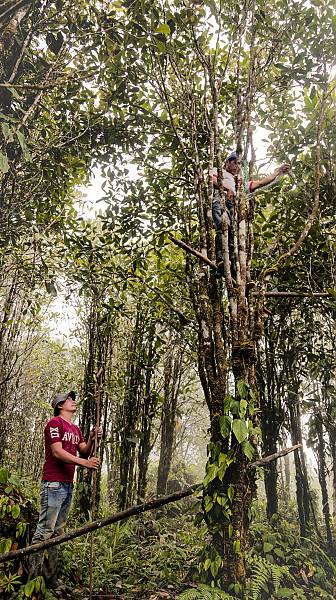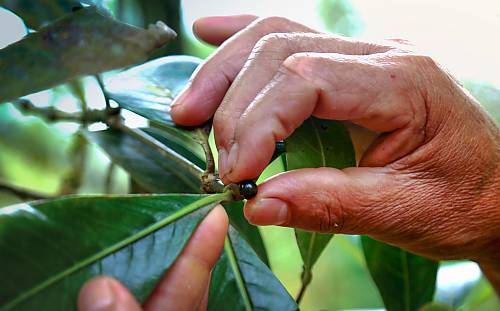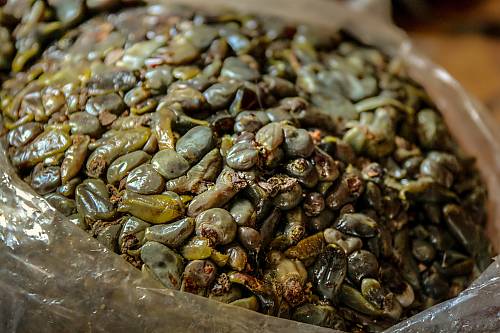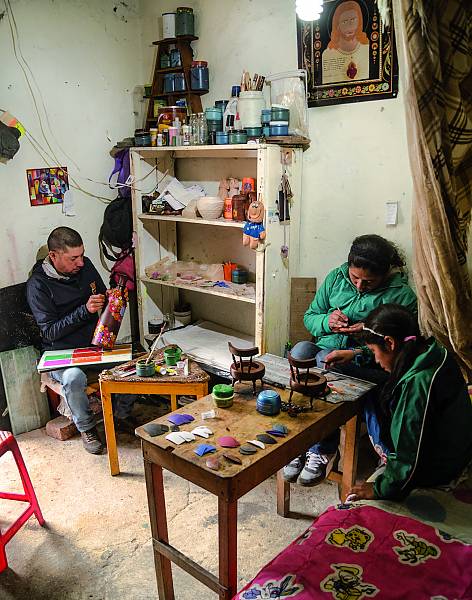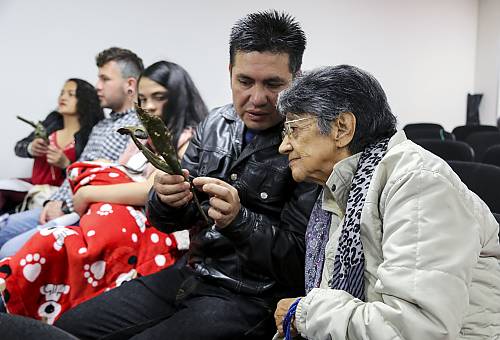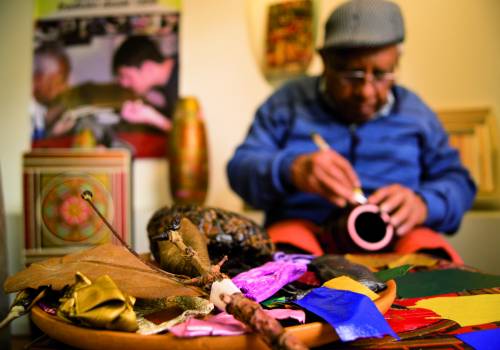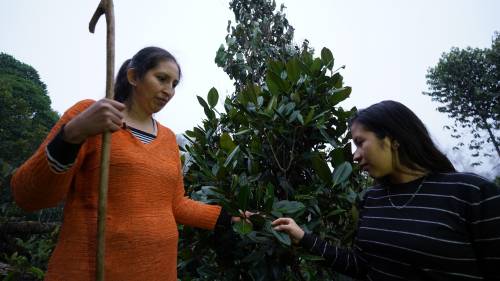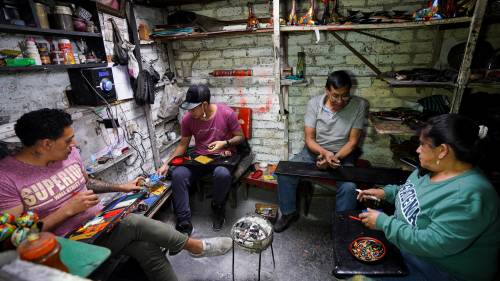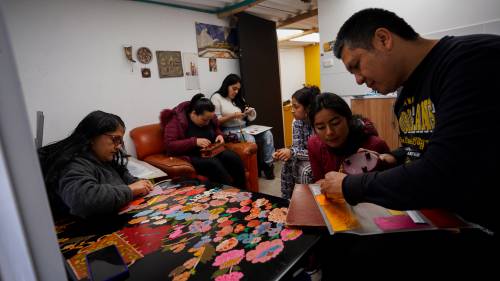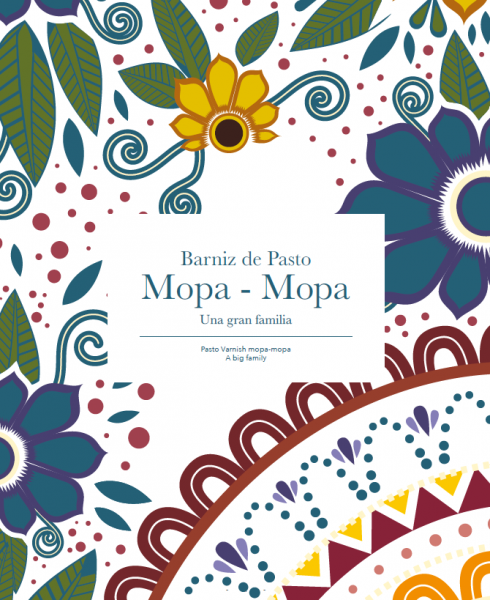Report on the status of an element inscribed on the list of intangible cultural heritage in need of urgent safeguarding
A. Cover sheet
A.1.
State Party
Name of State Party
Colombia
A.2.
Date of deposit of the instrument of ratification, acceptance, approval or accession
This information is available online.
Date of deposit of the instrument of ratification, acceptance, approval or accession
2008-03-19
A.3.
Element inscribed on the Urgent Safeguarding List that is the subject of this report
Name of element
Traditional knowledge and techniques associated with Pasto Varnish mopa-mopa of Putumayo and Nariño
Inscribed in
2020
Submitting State(s)
Colombia
A.4.
Reporting period covered by this report
Please indicate the period covered by this report.
A.5.
Other elements inscribed on the Urgent Safeguarding List, if any
Please list all other elements from your country inscribed on the Urgent Safeguarding List, together with the year of inscription; for multinational elements, please indicate the other States concerned.
Other elements inscribed on the Urgent Safeguarding List, if any
Traditional Vallenato music of the Greater Magdalena region (2015)
A.6.
Executive summary of the report
Please provide an executive summary of the report that will allow general readers to understand the current status of the element, any positive or negative impacts of inscription, the implementation of safeguarding measures during the reporting period and their possible update for the following years.
A.7.
Contact person for correspondence
Provide the name, address and other contact information of the person responsible for correspondence concerning the report.
Title (Ms/Mr, etc.)
Ms
Family name
Flórez Rodríguez
Given name
Ruth
Institution/position
Coordinator
Intangible Cultural Heritage
Minsitry of Culture
Address
Telephone number
E-mail address
rflorez@mincultura.gov.co
Other relevant information
B
Ms
B. Status of element inscribed on the Urgent Safeguarding List
Refer to the nomination file or to previous reports, if any, as the basis for reporting on the current status of the element, and report only on relevant changes since the date of inscription on the List or since the previous report. Nomination files, specific timetables and earlier reports, if any, are available at https://ich.unesco.org or from the Secretariat, upon request.
The State Party shall pay special attention to the role of gender and shall endeavour to ensure the widest possible participation of the communities, groups and, where applicable, individuals concerned as well as relevant non-governmental organizations during the process of preparing this report, and is asked to describe how it has done so in point D below.
B.1.
Social and cultural functions
Please explain the social and cultural functions and meanings of the element today, within and for its community, the characteristics of the bearers and practitioners, and any specific roles or categories of persons with special responsibilities towards the element, among others. Attention should be given to any relevant changes related to inscription criterion U.1 (‘the element constitutes intangible cultural heritage as defined in Article 2 of the Convention’).
Social and cultural functions
Traditional knowledge and techniques associated with Pasto Varnish mopa-mopa of Putumayo and Nariño refer to an artisanal technique of pre-Hispanic origin with over 800 years of history. This unique practice blends natural and cultural elements from the Amazon and the Colombian Andes, making it a biocultural reference at local, national, and global levels. Three traditional trades—harvesting, woodworking, and decorative varnishing—converge in this practice. The processes of harvesting mopa-mopa, transforming the wood, and decorating with varnish involve families who have passed down their knowledge and techniques through generations. Until recently, men received most of the visibility, even though women have always played a central role in its development. The proper articulation of these trades ensures the sustainability of the practice.
This cultural element is highly valued by the communities of Nariño and Putumayo as a means of expressing the cosmogony and unique creativity of the southern Andes of Colombia. Likewise, these communities deeply appreciate the biocultural knowledge preserved since pre-Columbian times, which enables both the responsible and highly sophisticated management of the raw material used to produce the varnish, derived from the mopa-mopa tree native to the Amazon foothills. This relationship with the mopa-mopa tree is regarded as a testament to the responsible use of the region's biodiversity. The practitioners involved in the three stages of this cultural expression mutually value each other's contributions. Notably, since the implementation of the safeguarding plan in 2024, dialogue and collaboration among these practitioners have significantly increased.
Today, there are 55 mopa-mopa harvesters, wood artisans, and decorators, along with 55 apprentices, working in equitable roles and receiving equal recognition for their contributions. Transmission activities have increased significantly as part of the safeguarding plan's implementation, providing crucial support for a practice that, in 2019, was under threat due to the declining number of practitioners. Today, there is a noticeable rise in youth participation in workshops and mopa-mopa harvesting activities, ensuring the continuity and revitalization of this cultural tradition.
Over 70% of the new practitioners are women, who are driving remarkable innovations and trends in design and colour. In many cases, these innovations are integrated into jewellery made from wood and metal.
B.2.
Assessment of its viability and current risks
Please describe the current level of viability of the element, particularly the frequency and extent of its practice, the strength of traditional modes of transmission, the demographics of practitioners and audiences and its sustainability. Please also identify and describe the threats, if any, to the element's continued transmission and enactment and describe the severity and immediacy of such threats, giving particular attention to any strengthening or weakening of the element’s viability subsequent to inscription.
Assessment of its viability and current risks
The viability of the element has increased since the implementation of the safeguarding plan began, as family-based teaching and learning processes have significantly increased. Previously, harvesters and master artisans worked in isolation at collection sites, workshops, and home studios. However, due to decisive action within the framework of the safeguarding plan, the number of apprentices has doubled over the past four years, rising from 55 to 110 individuals. These practitioners now engage in mopa-mopa harvesting in the Andean-Amazonian foothills of Putumayo, as well as wood transformation and varnish decoration in the municipality of Pasto, Department of Nariño. Thanks to gatherings of practitioners and exhibitions in Pasto and other locations worldwide, this artisanal technique now enjoys greater visibility. Markets have expanded, and an increasing number of audiences appreciate and value the craft at local, national, and international levels.
However, there are two significant risks threatening the knowledge associated with Pasto Varnish. The first relates to the scarcity of raw materials, specifically mopa-mopa and wood. Until recently, harvesting seasons occurred in May and November, but factors such as deforestation and climate change in the Amazon have altered these timelines. Collectors are now forced to harvest prematurely and continuously to collect buds before they melt due to heat or reach unsuitable growth stages, which can damage the bush or even burn the entire plant due to prolonged high temperatures. These challenges have led to human adaptation strategies to mitigate the impacts of global warming, such as caring for new bushes and rehabilitating plants damaged by fire.
The second risk concerns the scarcity of wood. Artisans who work with wood fear that their craft may become unsustainable in the coming years. Meanwhile, master decorators are exploring new surfaces for varnish application, such as leather, fabric, glass, paraffin, concrete, and metal. This exploration has led to the creation of new jewellery lines, predominantly led by women.
Additionally, there are issues with the inadequate marketing of raw materials, wooden products, and varnish-decorated works, which prevents equitable benefits for all practitioners. This discourages younger generations from continuing the craft, as they often prefer more stable and profitable employment opportunities. In some cases, this has led practitioners to prioritize quantity over quality, negatively impacting market prices and the perceived value of the technique. Compounding this issue is the proposed adoption of new technologies, which, although they may reduce the time and effort required for production, could also displace artisan labour, threatening the tradition further.
B.3.
Implementation of safeguarding measures
Please report on the safeguarding measures described in the nomination file, and previous report, if any. Describe how they have been implemented and how they have substantially contributed to the safeguarding of the element during the reporting period, taking note of external or internal constraints such as limited resources. Include, in particular, information on the measures taken to ensure the viability of the element by enabling the community to continue to practise and transmit it. Include the following detailed information concerning the implementation of the set of safeguarding measures or safeguarding plan:
B.3.a.
Objectives and results
Indicate what primary objective(s) were addressed and what concrete results were attained during the reporting period.
Objectives and results
The safeguarding plan, adopted in 2020, aims to preserve and ensure the sustainability of “The traditional knowledge and techniques associated with Pasto Varnish (mopa-mopa) of Putumayo and Nariño” in southwestern Colombia. To achieve this, five guidelines were established: research for sustainability, dignification of the trade and transmission of knowledge, organization and participation, assessment, social appropriation, and dissemination, and cultural entrepreneurship and marketing.
The dignification of the trade and transmission of knowledge has shown the most tangible progress. Teaching-learning processes with seven wood craftsmen and 38 varnishers have motivated 45 apprentices, who actively participate in activities. Efforts are ongoing with 10 mopa-mopa harvesters to ensure their apprentices continue the practice. The number of practitioners has increased to 110. The plan initially aimed to strengthen knowledge transmission with 37 people, but more than 60 apprentices—most of them women—are now involved, surpassing the goal. This was achieved with support from UNESCO, Colombia's Ministry of Culture, local governments, and the Mundo Espiral Foundation, which has supported artisans at various stages of production.
Improvements to working conditions include cabins and water transport hoses for collectors, benefiting their profession. However, only five varnishers’ home workshops have been improved, and wood craftsmen have yet to receive support. Additionally, elder practitioners have been included in a government program providing financial aid to senior citizens who contribute to cultural heritage. Four artisans have benefited, including two with degenerative illnesses.
The assessment, social appropriation, and dissemination guideline has also been impactful. Exhibitions in Pasto (2021-2024) and other locations have highlighted the production chain and the individuals involved, fostering recognition of their roles and increasing appreciation for this artisanal tradition.
In terms of research for sustainability, universities and institutions like the Mundo Espiral Foundation have advanced knowledge to support decision-making. The foundation has studied historical, sociological, environmental, and design aspects of Pasto Varnish, creating a comprehensive vision of the element. This work has resulted in a virtual repository of studies that will form part of a proposed Documentation Center.
Despite these successes, challenges remain. The scarcity of raw materials, exacerbated by climate change and deforestation, threatens the sustainability of the practice. Harvesters must adapt to changing seasons and environmental pressures, while wood artisans face a declining supply of wood. Furthermore, inadequate marketing and the potential adoption of new technologies could undermine the craft’s artisanal nature and discourage younger generations from continuing the tradition.
The safeguarding plan has strengthened the Pasto Varnish tradition, ensuring greater visibility, increased participation, and support for practitioners, while addressing critical threats to its sustainability.
B.3.b.
Safeguarding activities
List the key activities that were carried out during this reporting period in order to achieve these expected results. Please describe the activities in detail and note their effectiveness or any problems encountered in implementing them.
Safeguarding activities
According to the community participation and dialogue process conducted for the preparation of this report, the practitioners and bearers of the Pasto Varnish mopa-mopa tradition in Putumayo and Nariño believe that the implementation of the Safeguarding Plan during the 2020–2024 period has resulted in the following activities:
Line 1: “Research for Sustainability”
Studies and assessments on mopa-mopa, wood, techniques, and practitioners have been conducted by various organizations. However, further efforts are necessary to protect, cultivate, and sustainably manage the raw materials. The mopa-mopa bush is at significant risk due to factors such as deforestation, climate change, pests, and unclear land ownership. Harvesting is currently limited to 150 kilos per year across two seasons (May and November), and only 3.5 hectares are cultivated. To address the scarcity of wood, artisans are experimenting with applying varnish to new materials such as leather, fabric, plastic, glass, and metal, leading to the creation of jewelry lines, primarily driven by women.
Line 2: “Dignification of Work and Transmission of Knowledge”
This line has made the most progress. The conditions for mopa-mopa collection in the mountain jungles have improved with the construction of cabins and the installation of water transport hoses. Traditional knowledge has been strengthened with 55 apprentices—most of whom are women—across the entire production chain. Annual meetings in Pasto since 2021 have fostered trust and collaboration among those involved in the craft. However, seven wood workshops and 18 home workshops for varnish decoration still need to be upgraded.
Line 3: “Organization and Participation”
Four organizations have been established to facilitate the commercialization of raw materials and crafts: Asociación de Cultivadores y Comercializadores de la Resina del mopa-mopa (ASOMOPAMOPA) (2021), Fundación Cultural Barniz de Pasto mopa-mopa (2020), Fundación Cultural mopa-mopa Barniz de Pasto (2022), and Fundación Escuela-Taller Barniz de Pasto mopa-mopa (2023). However, many wood artisans and some individuals within the production chain prefer to remain independent, having experienced organizational challenges in the past.
Line 4: “Valuation, Social Appropriation, and Dissemination”
This line has also seen success, with the production of books, brochures, catalogs, audiovisual materials, and podcasts to disseminate knowledge about Pasto Varnish. Practitioners have fully embraced the Safeguarding Plan and its related documents, which will remain relevant for 2025–2028. Participation in fairs, exhibitions, and academic events has increased, although the Museum-Café, Documentation Center, Gallery, and Warehouse for varnished wooden works are still pending implementation.
Line 5: “Cultural Entrepreneurship and Marketing” (Pending Development)
Bearers identify this line as critical for business training, establishing local and international sales points, and forming export alliances. Training in design, computing, accounting, and foreign languages is also considered essential. They propose developing a sustainable tourism plan that benefits all actors in the production chain while respecting the natural and cultural spaces involved.
Finally, the bearers recommend adding two new components for the 2025–2028 period:
1. A focus on the co-responsibility of culture and nature, giving equal importance to both human and non-human elements.
2. Clearer definitions for roles (collector, artisan, apprentice, etc.) and spaces (mountain-jungles, workshops) to enhance the conceptual clarity of the Safeguarding Plan.
B.3.c.
Participation of communities, groups or individuals in the safeguarding activities
Describe how communities, groups or, if appropriate, individuals as well as relevant non-governmental organizations have effectively participated, including in terms of gender roles, in the safeguarding measures. Describe the role of the implementing organization or body (name, background, etc.) and the human resources that were available for implementing safeguarding activities.
Participation of communities, groups or individuals in the safeguarding activities
All safeguarding activities have been carried out with the active involvement of practitioners and bearers from Putumayo and Nariño.
The mopa-mopa harvesters consist of eight men and two women living in rural areas of Mocoa, Department of Putumayo. They were actively involved in the preparation of the Nomination File and Safeguarding Plan beginning in 2020 and have participated in all subsequent activities organized by public and private entities to revitalize the element. Some women have taken on significant leadership roles among the harvesters, excelling in cultivation, harvesting, and marketing. Teaching-learning processes are being conducted within families in the mountains and jungles of Putumayo, supported by the UNESCO International Assistance Fund and the Colombian Ministry of Cultures.
The wood craftsmen comprise seven men, six residing in the municipality of Pasto and one in El Peñol, Department of Nariño. They have been integrated into the implementation of the Safeguarding Plan and are currently conducting teaching-learning processes in their workshops. Notably, these workshops now include three women—a significant achievement, as this profession has historically been considered male-dominated.
The masters of Pasto Varnish consist of seven women and 31 men residing in the city of Pasto, Department of Nariño. They have participated in every safeguarding activity organized by public and private entities since 2012. Thanks to support from UNESCO, the Ministry of Cultures, and the Mundo Espiral Foundation, they are carrying out a teaching-learning process involving 25 women, many of whom are single mothers and heads of households. Although women have historically participated in various aspects of Pasto Varnish production, their leadership roles have become more prominent in recent years. Since 2020, seven women have been formally recognized as masters and are well-regarded within the craft community.
The Ministry of Cultures, Arts, and Knowledge of Colombia has supported the safeguarding and heritage process for this element from 2012 to the present. The commitment and responsibility of the Intangible Cultural Heritage and Memory Group and other affiliated agencies in managing and executing related projects deserve special recognition.
Finally, the Mundo Espiral Foundation, a non-governmental organization founded in Pasto in 2007 and accredited by ICH-UNESCO in 2022, has been a key partner in the heritage process at the departmental (2014), national (2019), and global (2020) levels since 2012. The foundation has established strong bonds of trust with the 55 individuals involved in the productive chain across Putumayo and Nariño.
B.3.d.
Timetable
Indicate in a timetable when each activity was implemented.
Timetable
In 2021, due to the pandemic caused by Covid-19, no specific project was carried out to safeguard the traditional knowledge and techniques associated with Pasto Varnish mopa-mopa of Putumayo and Nariño, to the extent that resources funds from the Municipal Culture Secretariat of Pasto and the Culture Directorate of the Nariño Government were assigned to address the situation faced by the artistic and craft sectors during the pandemic.
Execution date: March 5, 2022, to November 5, 2022.
Alliance: Government of Nariño, Mayor's Office of Pasto and Mundo Espiral Foundation.
Project: Phase I. Implementation of the Safeguarding Plan for traditional knowledge and techniques associated with Pasto Varnish mopa-mopa of Putumayo and Nariño.
Execution date: August 1, 2022, to April 30, 2024.
Alliance: ICH-UNESCO International Assistance Fund, Ministry of Cultures, Arts and Knowledge of Colombia, and Mundo Espiral Foundation.
Project: Between the Amazon and the Andes: safeguarding and transmission of traditional knowledge and techniques associated with Pasto Varnish mopa-mopa of Putumayo and Nariño, departments of Colombia.
Execution date: December 29, 2023, to April 29, 2024.
Alliance: Government of Nariño, Mayor's Office of Pasto and Mundo Espiral Foundation.
Project: Phase II. Implementation of the Safeguarding Plan for traditional knowledge and techniques related to Pasto Varnish mopa-mopa, Putumayo and Nariño, Intangible Cultural Heritage of Humanity.
Execution date: February 28, 2024, to September 10, 2024.
Alliance: Ministry of Cultures and Mundo Espiral Foundation.
Project: Between the Amazon and the Andes: safeguarding and transmission of traditional knowledge and techniques associated with the Pasto Varnish of Putumayo and Nariño, departments of Colombia. Phase I.
Execution date: February 28, 2025, to September 10, 2025.
Alliance: Ministry of Cultures, Arts and Knowledge, and Mundo Espiral Foundation.
Project: Between the Amazon and the Andes: safeguarding and transmission of traditional knowledge and techniques associated with Pasto Varnish of Putumayo and Nariño, departments of Colombia. Phase II.
Continuity to the process that began with the support of the International Assistance Fund for the Safeguarding of Intangible Cultural Heritage, period August 2022 to April 2024.
B.3.e.
Budget expenditures
Provide the detailed amounts of the funds used for the implementation of each activity (if possible, in US dollars), identifying the funding source for each (governmental sources, in-kind community inputs, etc.).
Budget
In 2021, a specific project was not carried out to safeguard the Pasto Varnish mopa-mopa, to the extent that the economic resources of the Pasto Culture Secretariat and the Nariño Government's Culture Directorate were allocated to address the situation that the arts and crafts sector faced during the pandemic caused by Covid-19.
Funding source: National Government (Ministry of Cultures).
Value: US$ 26,216.31
Year: 2022.
Project: Phase I. Implementation of the Safeguarding Plan for traditional knowledge and techniques associated with the Mopa-mopa Grass Varnish of Putumayo and Nariño.
Activities: diagnosis of the situation of 55 bearers, transmission of knowledge for 80 hours, meeting of the productive chain in Pasto, historical research on varnish, exhibition of the work of masters and apprentices, certification.
Funding source: ICH-UNESCO International Assistance Fund, National Government (Ministry of Cultures) and Mundo Espiral Foundation.
Value: US$98,925
Years: 2022 - 2024
Project: Between the Amazon and the Andes: safeguarding and transmission of traditional knowledge and techniques associated with Pasto Varnish mopa-mopa of Putumayo and Nariño, departments of Colombia.
Activities: development of a 150-hour teaching-learning process with 110 people. Meetings between participants in the productive chain, exhibition of the works carried out between masters and apprentices, compilation of the life and work of the 55 bearers, audiovisual production, book-catalogue in Spanish and English and certification.
Funding source: National Government (Ministry of Cultures).
Value: US$ 17,945.29
Years: 2023 - 2024
Project: Phase II. Implementation of the lines of action of the Safeguarding Plan of traditional knowledge and techniques associated with the Mopa-mopa Grass Varnish of Putumayo and Nariño, Intangible Cultural Heritage of Humanity.
Activities: transmission of knowledge for 40 hours with 110 lessons, investigation of artisanal techniques in different periods.
Funding source: National Government (Ministry of Culture).
Value: US$50,344.80
Year: 2024
Project: Phase I. Between the Amazon and the Andes: safeguarding and transmission of traditional knowledge and techniques associated with Pasto Varnish mopa-mopa of Putumayo and Nariño, departments of Colombia.
Activities: Continue the teaching-learning process with 110 people started in 2022 with the ICH-UNESCO International Financial Assistance Fund. There was also a meeting with participants in the production chain and an exhibition of their work.
Funding source: National Government (Ministry of Cultures).
Value: $220,000,000
Year: Project approved, to be executed in 2025.
Phase II. Between the Amazon and the Andes: safeguarding and transmission of traditional knowledge and techniques associated with Pasto Varnish mopa-mopa of Putumayo and Nariño, departments of Colombia.
Activities: Continue with the teaching-learning process that began in 2022 with the ICH-UNESCO International Financial Assistance Fund. Total beneficiaries: 110 people. There will also be a meeting with the participants of the production chain and an exhibition of their works.
B.3.f.
Overall effectiveness of the safeguarding activities
Provide an overall assessment of the effectiveness of the activities undertaken to achieve the expected results and of the efficiency of the use of funds for implementing the activities. Please indicate how the activities contributed to achieving the results and whether other activities could have contributed better to achieving the same results. Also indicate whether the same results could have been achieved with less funding, whether the human resources available were appropriate and whether communities, groups and individuals could have been better involved.
Overall effectiveness of the safeguarding activities
In conducting an evaluation related to the effectiveness and efficiency of the Safeguarding actions, it can be affirmed that the teaching-learning processes with wood artisans and varnishers are progressing in the best possible way. The process with mopa-mopa gatherers in Putumayo needs to be strengthened.
The Safeguarding Plan proposed strengthening the transmission of knowledge to 37 people during the 2021-2024 period. However, there are currently more than 60 apprentices – mostly women – thanks to international assistance provided by UNESCO and the support from the Biennial List of National Interest Projects from Colombia's Ministry of Culture, Arts, and Knowledge.
The dissemination of the entire production chain and the exhibitions throughout the year have become key strategies for understanding the importance of the crafts and recognizing each person involved in the world of varnish.
Regarding the dignification of the craft, the mopa-mopa gatherers express that the construction of huts and the placement of hoses in the mountain-forests for water transport have significantly improved their craft. In the case of the varnishing masters, the conditions of some home-workshops have been moderately optimized, although the vast majority have yet to be included. Meanwhile, the wood artisans express that none of their workshops have benefited, which is something that must be addressed.
Universities and other institutions have conducted research, and four elderly varnish artisans with limited resources have been included in the Government's Periodic Economic Benefits (BEPS) program, two of them suffering from degenerative diseases.
These objectives would hardly have been achieved without the financial, technical and human support of UNESCO, the Ministry of Cultures, Arts and Knowledge, the Government of Nariño, the Mayor's Office of Pasto, the Mundo Espiral Foundation and the community help of teachers. and Varnish Pasto mopa-mopa apprentices. It should be noted that both the women and men involved participate in each and every one of the safeguarding activities, since they see them as an opportunity to improve the commercialization of their works, their economic income and, therefore, their quality of life.
It is important to note that the same results could not have been achieved with less funding. The existence of natural resources (mop-mop and wood) and human resources (craftsmen, apprentices and professionals in different fields) was essential to achieve a comprehensive vision of the element, its problems and the possible actions to take to maintain this cultural heritage element. The most important topics to develop in the period 2025-2028 are related to conservation and access to raw materials, entrepreneurship and marketing.
C
Flórez Rodríguez
C. Update of the safeguarding measures
C.1.
Updated safeguarding plan
Please provide an update of the safeguarding plan included in the nomination file or in the previous report. In particular provide detailed information as follows:
- a. What primary objective(s) will be addressed and what concrete results will be expected?
- b. What are the key activities to be carried out in order to achieve these expected results? Describe the activities in detail and in their best sequence, addressing their feasibility.
- c. How will the State(s) Party(ies) concerned support the implementation of the updated safeguarding plan?
Updated safeguarding plan
Objective:
Strengthen cultural entrepreneurship and contribute to improve the livelihoods of bearers of the Pasto Varnish (mopa-mopa) production chain, including wooden works and items decorated with varnish.
Activities:
Continue implementing the Safeguarding Plan focusing on: “Research for Sustainability,” “Dignification of Work and Transmission of Knowledge,” “Organization and Participation,” and “Valuation, Social Appropriation, and Dissemination.” Prioritize strengthening actions that remain underdeveloped:
Develop and implement a learning program in business training tailored to the bearers, covering accounting and legislation relevant to crafts in Colombia and globally.
Create and execute a diploma program in industrial and graphic design, contextualized for bearers, emphasizing exploration and innovation in applying Pasto Varnish to wood and alternative materials.
Facilitate the acquisition of new language skills (e.g., English, French, Mandarin) to enhance global commercial relations.
Protect and value traditional knowledge and techniques through mechanisms like Denomination of Origin, Handmade Seals, and Copyright registrations.
Promote sustainability of raw materials (mopa-mopa and wood) while improving pricing structures within the production chain.
Forge strategic alliances to enable direct exports of artisanal wooden products decorated with varnish, ensuring better market rates.
Design and implement marketing and advertising strategies at local, national, and international levels to bolster Pasto Varnish's visibility and safeguarding efforts.
Support from the State Party:
The involvement of three key state entities is vital for supporting the execution of these activities:
Ministry of Cultures
Support will be provided through the following mechanisms:
Biennial Projects of National Interest under the National Concertation Program.
Projects within the National Stimulus Program.
Funds from the National Consumption Tax (INC).
Specific contracts and agreements dedicated to safeguarding actions.
Government of Nariño
Contributions include:
Funds from the National Consumption Tax (INC).
Procultura Stamp resources.
Departmental Stimulus Calls.
Specific contracts and agreements for safeguarding initiatives.
Pasto Mayor’s Office
Support mechanisms include:
Funds from the National Consumption Tax (INC).
Procultura Stamp resources.
Local Stimulus Calls.
Specific contracts and agreements to advance safeguarding activities.
C.2.
Timetable for future actitivies
Provide a timetable for the updated safeguarding plan (within a time-frame of approximately four years).
01095
Timetable
Continue the Development of the Safeguard Plan: Focus on “Research for Sustainability,” “Dignification of the Profession and Transmission of Knowledge,” “Organization and Participation,” and “Evaluation, Social Appropriation, and Dissemination,” prioritizing actions requiring further strengthening (2025–2028).
Update the 2025–2028 Safeguard Plan: Revise the plan based on the evaluation conducted in 2024 (2025).
Design and Implement a Business Training Program: Develop a contextualized learning program covering accounting and legal frameworks related to crafts in Colombia and export processes, tailored for bearers (2025).
Develop a Learning Program in Industrial and Graphic Design: Focus on contextualized exploration and experimentation with the application of Pasto Varnish on wood and alternative supports (2026).
Facilitate Language Learning: Enable bearers to learn a new language (e.g., English, French, Mandarin) to enhance global commercial relations (2025–2028).
Recognize and Protect Traditional Knowledge and Techniques: Utilize mechanisms such as Designation of Origin, Handmade Seal, and Copyright to safeguard and promote these traditions (2025–2026).
Enhance Raw Material Sustainability: Strengthen the cultivation and sustainable use of mopa-mopa and wood while improving their value within the production chain (2025–2028).
Establish Strategic Alliances for Direct Export: Form partnerships to enable the direct export of wooden and varnish-decorated artisanal products (2025–2028).
Develop Comprehensive Marketing and Advertising Strategies: Create and implement local, national, and global marketing campaigns to support the promotion and safeguarding of Pasto Varnish (2025–2028).
C.3.
Budget for future activities
Provide the estimates of the funds required for implementing the updated safeguarding plan (if possible, in US dollars), identifying any available resources (governmental sources, in-kind community inputs, etc.).
Budget
Activities and Budget:
• Continuation of Safeguard Plan Development:
Advance the lines of action outlined in the Safeguard Plan, focusing on "Research for Sustainability," "Dignification of the Profession and Transmission of Knowledge," "Organization and Participation," and "Assessment, Social Appropriation, and Dissemination." This includes strengthening underdeveloped areas and consolidating the Pasto Varnish Museum.
Budget: $1,500,000,000 COP (US$343,155.45) for 2025–2028.
• Diploma in Business Training:
Design and execute a program covering accounting and legislation related to crafts in Colombia and international markets, tailored for bearers.
Budget: $40,000,000 COP (US$9,150.11) by 2025.
• Diploma in Industrial and Graphic Design:
Design and execute a program on contextualized industrial and graphic design, focusing on exploration and experimentation with Pasto Varnish applications on wood and other materials.
Budget: $70,000,000 COP (US$16,012.70) for 2026.
• Language Training:
Facilitate language learning (English, French, Mandarin, or others) for bearers to enhance international trade relations.
Budget: $300,000,000 COP (US$68,625.84) for 2025–2028.
• Protection of Traditional Knowledge and Techniques:
Implement mechanisms such as Designation of Origin, Handmade Seal, and Copyright to safeguard traditional knowledge and techniques.
Budget: $100,000,000 COP (US$22,875.50) for 2025–2026.
• Sustainability of Raw Materials:
Strengthen the sustainability of raw materials (mopa-mopa and wood) and improve their pricing within the production chain.
Budget: $400,000,000 COP (US$91,499.40) for 2025–2028.
• Strategic Export Alliances:
Establish partnerships to directly export artisanal products, including varnished wooden items, to improve market prices.
Budget: $250,000,000 COP (US$57,186.60) for 2025–2028.
• Marketing and Advertising Strategies:
Design and implement marketing and advertising campaigns at local, national, and global levels to enhance the commercialization of Pasto Varnish and its safeguarding.
Budget: $400,000,000 COP (US$91,499.40) for 2025–2028.
Potential sources for funding:
The National Government (Ministry of Culture, Ministry of Industry and Commerce, Ministry of Environment, Ministry of Agriculture, Artesanías de Colombia), the Government of Nariño (Administrative Directorate of Culture), the Mayor's Office of Pasto (Secretariat of Culture), the Government of Putumayo (Indercultura-Putumayo), and the Mayor's Office of Mocoa (Secretariat of Education and Culture).
C.4.
Community participation
Please describe how communities, groups and individuals, as well as relevant non-governmental organizations have been involved, including in terms of gender roles, in updating the safeguarding plan, and how they will be involved in its implementation.
00049
Community participation
For the update of the Safeguarding Plan, the Ministry of Cultures, Arts, and Knowledge of Colombia established an alliance with the Mundo Espiral Foundation to carry out a participatory consultation process. This process focused on assessing the achievements of the Safeguarding Plan implemented from 2020 to 2024 and developing an updated proposal.
Six open participation sessions were organized, engaging bearers of the cultural manifestation, civil society organizations, and local authorities. During these sessions, participants discussed the accomplishments of the Safeguarding Plan and proposed updates for its improvement. Each session saw an average of 75 participants, providing diverse perspectives and insights.
The results of these consultative sessions form the foundation of the information presented in this report and served as key inputs for the updated Safeguarding Plan proposed here.
The implementation of the updated plan will continue to involve the active participation of the bearers, both in its planning and execution, ensuring they play dual roles as leaders of the actions and primary beneficiaries.
C.5.
Institutional context
Please report on the institutional context for the local management and safeguarding of the element inscribed on the Urgent Safeguarding List, including:
- a. the competent body(ies) involved in its management and/or safeguarding;
- b. the organization(s) of the community or group concerned with the element and its safeguarding.
2008-03-19
Institutional context
Three key public organizations have played a crucial role in the management of the safeguarding efforts: the Ministry of Cultures, Arts, and Knowledge of Colombia, the Government of the Department of Nariño, and the Municipal Mayor's Office of Pasto. More effort will be carried out to guarantee the engagement of the Department of Putumayo and the Municipality of Mocoa.
Mundo Espiral Foundation has been key in leading civil society efforts towards the safeguarding of the element. This foundation has supported the safeguarding process of the Pasto Varnish mopa-mopa since 2012 and was accredited by ICH-UNESCO in 2022.
The organizations representing the bearers, who are interested in the element and its commercialization, include: the Association of Mopa-Mopa Resin Producers and Marketers ("ASOMOPAMOPA," established in 2021), the "Fundación Cultural Barniz de Pasto mopa-mopa" (2020), the "Fundación Cultural Mopa-Mopa Barniz de Pasto" (2022), and the "Fundación Escuela-Taller Barniz de Pasto mopa-mopa" (2023). However, several individuals within the productive chain prefer to remain independent, avoiding involvement in associations due to the challenges and failures experienced in past decades.
D
Ruth
D. Participation of communities in preparing this report
Describe the measures taken to ensure the widest possible participation of the communities, groups and, where applicable, individuals concerned as well as relevant non-governmental organizations during the process of preparing this report.
Participation of communities in preparing this report
To ensure the widest possible participation in the preparation of this report, the Ministry of Cultures, Arts and Knowledge, in alliance with Mundo Espiral Foundation, applied a qualitative and quantitative approach that involved carrying out 55 surveys, one for each person currently linked to the productive chain in Putumayo and Nariño; 55 interviews and life stories, 10 ethnographies in the mountains-jungles, workshops, home-workshops and 8 focus meetings between August and December 2024, in which the following activities were carried out:
1. Delivery of a handbook to the 55 bearers: “File and Safeguarding Plan of the traditional knowledge and techniques associated with the Pasto Varnish mopa-mopa, Putumayo and Nariño.”
2. Presentation by the Mundo Espiral Foundation: analysis of the UNESCO File and Safeguarding Plan, Pasto Varnish mopa-mopa, Putumayo and Nariño.
3. Conversation: ¿artists and/or craftsmen in cultural heritage?
4. Conversation: cultural industry and cultural heritage.
5. Conversation: cultural heritage and brand generation.
6. Discussion: ¿What progress has been made with the implementation of the Safeguarding Plan? ¿What should continue? ¿What needs to be omitted? ¿What needs to be attached?
7. Conversation: reflections on the UNESCO File and Plan for the Safeguarding of Knowledge and traditional techniques associated with the Pasto Varnish mopa-mopa of Putumayo and Nariño.
8. Assembly: socialization of results, presentation, and adjustments to the final ICH-011 UNESCO format in Spanish to be translated into English.
E
Coordinator
Intangible Cultural Heritage
Minsitry of Culture
E. Signature on behalf of the State Party
The report should be signed by an official empowered to do so on behalf of the State, and should include his or her name, title and the date of submission.
Name
Mónica Orduña Monsalve
Title
Director of Heritage and Memory
Date
13-12-2024
Signature
Upload signed version in PDF

